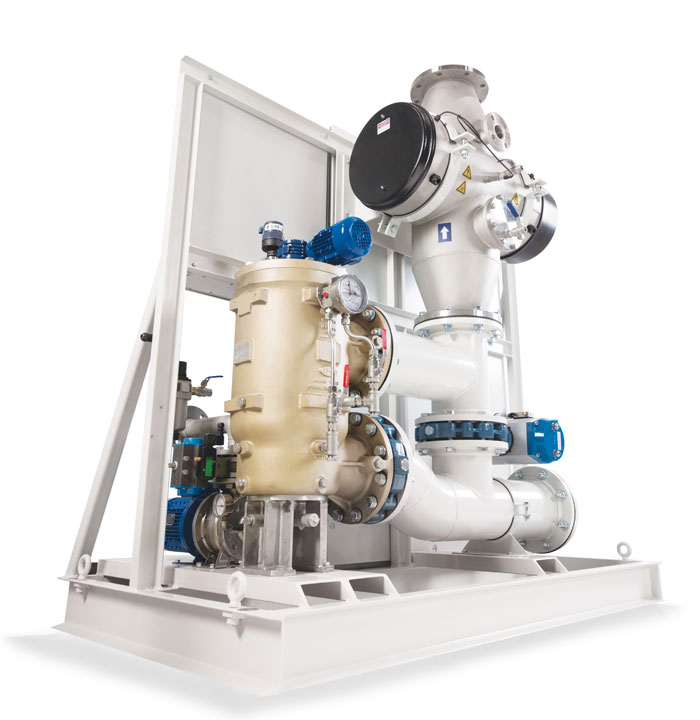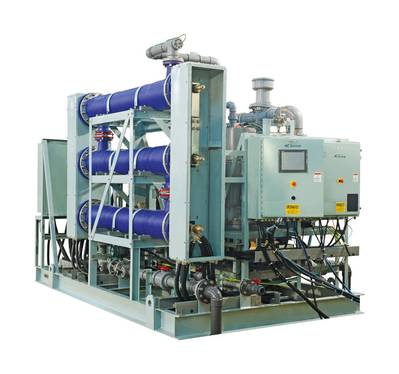BWM Compliance Is Critical to Protecting Our Environment
At De Nora, our ballast water management solutions tap our century of innovation and environmental leadership to keep a vessel’s BWMS performing at its peak – helping to prevent unnecessary and unanticipated downtime, which help increase vessel and operational efficiency.
At no time in recorded history has there been a more significant shift in the way economies work or the way goods and services move around the globe. The same is true for the regulatory landscape surrounding the maritime industry.
Regulations associated with ballast water management, low-sulfur fuels, biofouling and more are reshaping the global maritime space. While designed to help protect waterways so they can remain viable transport thoroughfares and environment for us all to enjoy, those some regulations, have placed an economic and administrative burden on ship owners and operators. Against the backdrop of the lingering global pandemic, global supply chain disruptions, and geopolitical uncertainties, most regulations add cost to the bottom line for ship owners and consequently to all other supply chains.
Therefore, compliance is critical to protect our environment. Failure to do so will be more costly.
At De Nora, our water experts manufacture and design economical and operationally efficient Ballast Water Management Systems (BWMS) – reducing the environmental impact of shipping by helping shipowners and operators protect against aquatic invasive species.
Beyond environmental compliance, we provide equipment, which has a minimal impact on ships, crews and the bottom-line. While adding a ballast water management system to a vessel does nothing to improve its performance, the wrong choice in selecting a BWMS can make things more difficult for crews, turnaround time and, in the end, profitability.
Choosing a BWMS has never been more crucial. Supply chain headwinds on land and sea continue to reshape the fundamental way raw material makes its way to the manufacturing floor. Ballast water equipment manufacturers are not immune to these dynamics. With proper planning, companies like De Nora can work alongside shipowners and operators to ensure selection, design application, installation and commissioning of a BWMS is as easy as possible.
When environmental technologies drive regulation as is the case with ballast water, there is an understandable prejudice to select the least expensive solution, which meets the minimum requirements of the regulation. While everyone wants the best deal, the least expensive upfront price is not necessarily the least expensive solution in the long run.
Simply installing a BWMS with the required Type Approvals does not equal compliance with the regulation. Ballast water management systems must work in the real world – verified by performance testing over the lifecycle of the equipment. It must be maintained and easy to operate. The value a BWMS provider brings to its customers is more than the acquisition cost. After all, owners and operators need their vessels to operate at near-peak performance to ensure they are fulfilling their promises to their customers.
Two Solutions, One Goal: Compliance
At De Nora, our ballast water management solutions tap our century of innovation and environmental leadership to keep a vessel’s BWMS performing at its peak – helping to prevent unnecessary and unanticipated downtime, which help increase vessel and operational efficiency.
Moreover, BWMS manufacturers, shipowners and operators, among others, must work together to ensure the water on which our world depends can efficiently move cargo full of products, parts and materials. With water covering 70 percent of the globe, keeping it safe and viable is our collective responsibility. We can do that by helping to deploy proven BWMS solutions to the marketplace, which can be applied to any vessel.
De Nora BALPURE® BWMS harnesses the use of filtration and electrochlorination (EC), and the Hyde GUARDIAN® BWMS taps filtration and ultraviolet (UV)-based technology, offering versatile dose control for vessels of all sizes and types.
Both the BALPURE and Hyde GUARDIAN BWMS have been extensively installed on vessels across the global maritime industry and are approved to meet the IMO D-2 and USCG requirements to prevent the spread of invasive species into non-native waters through ballast water. Both systems hold several class and hazardous area approvals, including ATEX, for maximum installation flexibility.
In the Clarksons Research published in the October 2022 BWMS report, it noted 50 percent of ships have installed BWM systems using electrochlorination and 33 percent have installed UV-based systems.
The Hyde GUARDIAN BWMS is particularly well suited for vessels with ballast water flow rates of up to 3000 m3/h, while the BALPURE BWMS is generally preferred for flow rates exceeding 1500 m3/h. Both technologies have advantages for different applications, and, without bias, De Nora can help an owner select the right technology for their application.
BALPURE – The EC Energy Advantage
The BALPURE BWMS delivers further cost benefits specific to energy consumption – a crucial factor when selecting a ballast water management system for a vessel.
After all, the kind of system chosen can impact a ship’s operational expenses (OPEX) for the life of the vessel. And, slip-stream EC systems provide a cost-effective solution, especially for existing vessels with high-ballast requirements, as well as when there is limited space available.
With the BALPURE BWMS, shipowners and operators get the unique advantage of a smart EC technology designed to help better manage OPEX by mitigating expenses related to energy consumption. The BALPURE BWMS utilizes slip-stream technology, which allows the electrolysis equipment to be remotely mounted – independent of the ballast lines. All other components can be separated into smaller sub-assemblies for installation flexibility. The equipment can be located conveniently throughout the vessel and filters can be placed in hazardous zone-rated areas, ensuring the BALPURE BWMS can be used on Tankers or LNG vessels ships.
Additionally, the slip-stream technology allows BALPURE to better control the inputs into the electrochlorination equipment. This provides an energy saving to the ship operator as the BWMS is never trying to create hypochlorite in substandard conditions. The dosing of hypochlorite can also be varied depending on how challenging the local water conditions are.– enabling operators to comply with the most challenging waters, such as waters with low salinity or low temperature at the most optimum level.
The demand for power to drive a BWMS is important. Particularly, there are variances between operating demand and the maximum installed power required for BWMS.
Retrofits can present some integration challenges, because the ship was designed without the BWMS load in mind. Estimating the OPEX of a BWMS requires a calculation based on understanding typical power demand, water conditions, rated TRC and probable or actual flow rates, and total ballast water treated (or re-treated for some technologies).1 The experts at De Nora are happy to support with understanding how this might affect your vessel.
Hyde GUARDIAN – The Efficient Choice
While power consumption is an important factor in a BWMS operation, it’s not the only thing shipowners and operators must consider.
One of the ways the Hyde GUARDIAN BWMS drives operational efficiency for operators and crews is by enabling proper exposure of microorganisms to UV light based on the quality of water in the ballast system.
Micro-organisms must be properly exposed to the wavelength of light produced by medium-pressure UV lamps to be effectively treated and comply with ballast water treatment regulations. The quality of the water in a UV treatment system determines how much UV light can pass through it. The water quality into a BWMS is constantly changing due to changes in port, season and passing traffic so it is critical to manage the dose of UV to get the most out of your BWMS.
The ability of UV light to pass through the water is called Ultraviolet Transmittance or UVT. For the appropriate amount of UV light to reach organisms and disinfect ballast water, the UVT of the water needs to be considered Hyde GUARDIAN leads the BWMS market in providing treatment at the lowest UVT – as low as 39 percent UVT – meaning it operates optimally in virtually every port around the globe, even where organic molecules or minerals are present in the water – inactivating the micro-organisms so they cannot pass through the UV system without being exposed to treatment.
Combined with a filtration system to deliver the flexibility needed in even the poorest of water qualities, no organisms are left untreated, and no excess energy consumed.
The Hyde GUARDIAN BWMS leverages an automatic cleaning system to maintain UV lamp efficiency as well as proprietary software, which will increase or decrease lamp power as needed, alongside effluent valve modulation to decrease flow rates. These features permit maximum flow in any water condition to help lower OPEX and reduce energy. The Hyde GUARDIAN BWMS also still boasts one of the world’s smallest installation footprints and can be customized for challenging vessel types and can be installed in up to seven days.
 Hyde GUARDIAN® Ballast Water Management System | UV transmission (UVT) determines the capability of UV light to penetrate water. When UV-T is high, UV light can penetrate deeply into the water. When the UV-T is low, UV light can only penetrate the water for a limited distance. Having a BWMS, which is effective in waters with low UVT means it will treat and meet IMO and USCG discharge standards. Hyde GUARDIAN can treat ballast water and effectively kill organisms down to 39 percent UVT, which means even challenging waters can be treated to meet both IMO and USCG discharge standards. |
BALPURE and Hyde GUARDIAN – Covering the Globe
In addition to the intuitively designed ballast water management systems, De Nora Marine Technologies stands behind the equipment to ensure operators and owners stay in compliance anywhere in the world.
Coupled with either a BALPURE or Hyde GUARDIAN BWMS is DE NORA VIA™ technology, which leverages the industry’s first automated performance analytics solution, the Data Log Analysis Utility (DLAU).
DE NORA VIA technical support specialists can remotely connect with vessel operators in real time, providing support services when crews need it most, deploying DLAU to give operators monthly BWM System performance reports to better track efficiency and compliance.
This industry leading deep operational and cost-mitigation data helps shipowners and operators identify problems before they become a reality – heading off costly repairs and helping to save time and money.
Any Ship, Any Time Anywhere
The water experts at De Nora are committed to working with shipowners and operators of all ship types to ensure the successful delivery and installation of a BALPURE or Hyde GUARDIAN BWMS. Our after-install service commitment is equally impressive, ensuring operators and crews have the coverage they need no matter where they are around the globe.
For more information about how De Nora can deliver the efficiency needed to ensure compliance with ballast water treatment regulations, please visit www.denora.com.
1.Ballast Water Management Advisory, ABS, 2019




